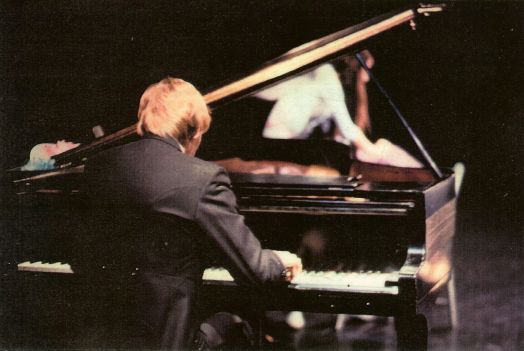Garry Laycock: Australian musician 1944-1988
By
Paul Bentley
 |
| Garry Laycock performing in the
Australian Ballet's production The Concert, 1979. |
Garry Laycock — who also
performed and wrote original compositions and arrangements under the name Leon
Gibbons — was born in Bingara, NSW, on 22 June 1944. After an education at
Newcastle Boys’ High School and Newcastle University, he spent his early
working life teaching music and languages in the Newcastle district and, at
South Sydney Boys’ High School, where he was Languages Master.
The development of his
musical talent began with the piano accordion at the age of seven. Three years
later, his parents enrolled him at the Newcastle Conservatorium to begin piano
studies under the tutelage of Joyce Blewitt.
In 1959, at the age of 15,
he was invited with four other Newcastle Conservatorium students, to compose
music to be arranged by John Antill and performed by the Sydney Symphony
Orchestra during a concert for schools.
His musical
studies under Frank Hutchens, Alexander Sverjensky and Gordon Watson
culminated in a performer's diploma at the Sydney Conservatorium .
In 1977, he joined the
Australian Ballet as resident pianist and was concerto soloist for numerous
ballet productions, notably Ballanchine’s Ballet Imperial and Grahame
Murphy’s Beyond Twelve, for which he played the G major concertos of
Tchaikovsky and Ravel each evening for a total of 42 performances in 21 days
at the Sydney Opera House.
Because of his work on the
Australian Ballet’s Anna Karenina, British composer Guy Wolfenden, in
Australia to arrange the music for the ballet, was moved to comment in the
Sydney Morning Herald: “Garry is absolutely brilliant, one of the best
repetiteurs I’ve ever heard. I think that Andre Prokovosky [the choreographer]
has completely changed the feel and tempo of many of the numbers during the
creative process of working with a brilliant pianist.”
In 1981, he joined the
Australian Opera as repetiteur, performing the daily routine of coaching,
rehearsals and pit duties. The Australian Opera gave him the opportunity to do
what he liked most of all — accompanying singers. Nothing gave him as much
pleasure as the annual Australian Opera benevolent concerts, which allowed him
to give expression to his sense of fun and affection for the songs of bygone
days.
Inventiveness and humour
are hallmarks of his original compositions and arrangements, bearing such
titles as A Fairly Grand Tarantella from a Night or Two at the Opera,
Tiptoe Through the Tulips (arranged for the Sydney Clarinet Quartet),
Hoagy Carmichael’s Lazybones, arranged for two oboes and cor anglais,
and Santa Has an Accident (for horn and strings).
During his time with the
Australian Opera, he gave numerous concerts and broadcasts - as accompanist
and soloist — for other organisations, including the Australian Broadcasting
Corporation and Sydney Opera House Trust. His broadcasts included
performances at the Sydney Opera House of Herzogenberg’s Trio for Piano,
Oboe and Horn, Op 62 and his own arrangements of Mendelssohn’s Songs
without Words. His arrangements of Tiptoe through the Tulips and
Lily of Laguna were broadcast by the Sydney Clarinet Quartet. With
conductor Bill Reid and the Elizabethan Sydney Orchestra in 1986, he performed
Mozart’s Piano Concert no 21 in C major K467 in the Concert Hall of the
Sydney Opera House as part of the Mostly Mozart Festival. In 1987, he
performed with Anthony Warlow in Theatre South’s production of Melvin Morrow’s
A Song to Sing O. He also appeared as a pianist in the film
Burke and Wills.
Garry died, after a
protracted illness, in Sydney on 15 December 1988.
In his review of the annual
Highlights of Opera concert at the Sydney Opera House on 27 August 1989, Peter
McCallum concluded his review with the following comments: “The evening
involved tributes to one present and one sadly absent friend. John Shaw, drew
warm applause for arias by Borodin and Verdi. The latter was pianist Garry
Laycock, accompanist at previous Highlights, whose untimely death earlier this
year deprived the AO of a richly appreciated, if unsung, talent.”
His musical compositions,
copies of programs, photographs, clippings and other documents have been
deposited in the State Library of New South Wales.
Compositions
Performances